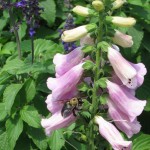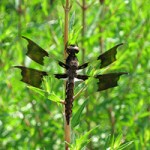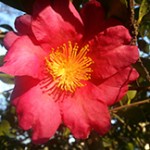How to Attract…
 Bees – Single blossom flowering plant materials have more pollen and are more attractive to bees than multi-blossom flowering plants. Plant blue, purple, and yellow varieties to attract beneficial bees. Plant a variety of flowering plants that will attract bees all year long, and incorporate many natives plants and wildflowers. Bees are among the best pollinators, and with nearly 85% of your flowering and fruiting plants requiring pollination they are a great free option.
Bees – Single blossom flowering plant materials have more pollen and are more attractive to bees than multi-blossom flowering plants. Plant blue, purple, and yellow varieties to attract beneficial bees. Plant a variety of flowering plants that will attract bees all year long, and incorporate many natives plants and wildflowers. Bees are among the best pollinators, and with nearly 85% of your flowering and fruiting plants requiring pollination they are a great free option.
Some plant suggestions: Zexmenia, Camelia, Daisy, Zinnia, Aster, Larkspur, Columbine, Snapdragon, Alyssum, Blueberry, Bee Balm, Southern Magnolia, Hollyhock, Foxglove, Roses, Crocus, Lavender, Clover, Indian Hawthorn, Sunflower
Hummingbirds– Red, pink, and orange tubular flowers will attract hummingbirds  more than yellow and white, and planting large patches of the same type of flowering plant will provide more nectar. Hummingbirds are great pollinators for flowers that are too narrow for most insects and birds to pollinate.
more than yellow and white, and planting large patches of the same type of flowering plant will provide more nectar. Hummingbirds are great pollinators for flowers that are too narrow for most insects and birds to pollinate.
Some plant suggestions: Cross Vine, Begonia, Salvia greggii, Azalea, Mexican Honeysuckle, Gold Star Esperanza, Bottlebrush, Texas Gold Columbine, Pentas, Glossy Abelia, Ajuga, Canna, Whirling Butterflies, Hibiscus, Shrimp Plant, Turk’s Cap, Red Yucca
Birds– Birds in the landscape can help control pests as well as keep weeds under control as they often consume weed seeds. Birds are also known pollinators.
Some plant suggestions: Mulberries, Beautyberry, Hackberries, Aster, Ligustrum, Viburnum, Chinese Pistache, Lantana, Female Texas Persimmon, Purple Coneflower, Sunflower, Agarita, Dogwood
 Butterflies– Butterflies don’t just need protection in the landscape, but their larvae provide food for other animals and reptiles in the area that will keep a landscape free of pests.
Butterflies– Butterflies don’t just need protection in the landscape, but their larvae provide food for other animals and reptiles in the area that will keep a landscape free of pests.
Some plant suggestions: Lantana, Bougainvillea, Glossy Abelia, Hollyhock, Azalea, Butterfly Bush, Daylily, Flame Acanthus, Impatiens, Passionflower
Deer– Landscaping in the Hill Country can be a challenge as deer will eat a residential or commercial landscape especially during drought conditions. It is best to choose all deer resistant plant varieties to avoid frequent plant replacement and bare areas in the landscape.
Some Resistant plant suggestions: Firebush, Mealy Blue Sage, Rosemary, Juniper, Nandina, Mexican Heather, Salvia greggii